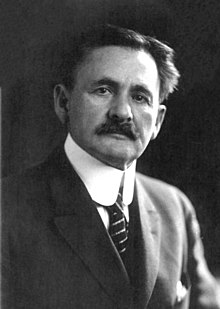Albert A. Michelson
| Albert A. Michelson | |
|---|---|
 |
|
| Born |
December 19, 1852 Strzelno, Kingdom of Prussia (modern Poland) |
| Died | May 9, 1931 (aged 78) Pasadena, California |
| Nationality | United States |
| Fields | Physics |
| Institutions |
Case Western Reserve University Clark University University of Chicago |
| Alma mater |
United States Naval Academy University of Berlin |
| Doctoral advisor |
Hermann Helmholtz Alfred Cornu |
| Doctoral students | Robert Millikan |
| Known for |
Speed of light Michelson–Morley experiment |
| Notable awards |
Matteucci Medal (1903) Nobel Prize in Physics (1907) Copley Medal (1907) Elliott Cresson Medal (1912) Henry Draper Medal (1916) Albert Medal (1920) Franklin Medal (1923) Duddell Medal and Prize (1929) |
| Spouse | Margaret Hemingway (1877–1898; divorced; 3 children) Edna Stanton (1899–1931; his death; 3 children) |
| Signature | |
Albert Abraham Michelson (surname pronunciation anglicized as "Michael-son", December 19, 1852 – May 9, 1931) was an American physicist known for his work on the measurement of the speed of light and especially for the Michelson–Morley experiment. In 1907 he received the Nobel Prize in Physics. He became the first American to receive the Nobel Prize in sciences.
Michelson was born in Strzelno, Province of Posen in Prussia (now Poland) into a Jewish family. He moved to the US with his parents in 1855, at the age of two. He grew up in the mining towns of Murphy's Camp, California and Virginia City, Nevada, where his father was a merchant. His family was Jewish by birth but non-religious, and Michelson himself was a lifelong agnostic. He spent his high school years in San Francisco in the home of his aunt, Henriette Levy (née Michelson), who was the mother of author Harriet Lane Levy.
President Ulysses S. Grant awarded Michelson a special appointment to the U.S. Naval Academy in 1869. During his four years as a midshipman at the Academy, Michelson excelled in optics, heat, climatology and drawing. After graduating in 1873 and two years at sea, he returned to the Naval Academy in 1875 to become an instructor in physics and chemistry until 1879. In 1879, he was posted to the Nautical Almanac Office, Washington (part of the United States Naval Observatory), to work with Simon Newcomb. In the following year he obtained leave of absence to continue his studies in Europe. He visited the Universities of Berlin and Heidelberg, and the Collège de France and École Polytechnique in Paris.
...
Wikipedia
